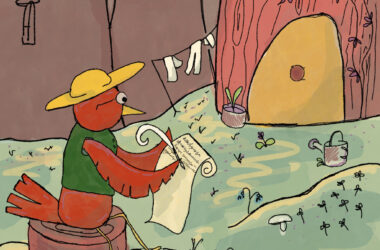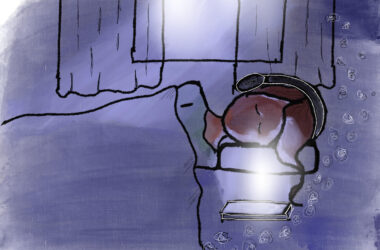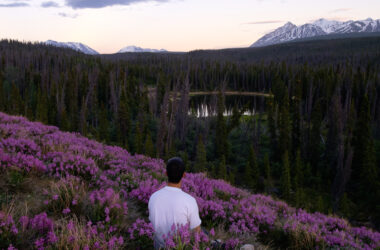“I can always point out your great uncle Charlie right away. I think he must’ve had a different father,” my grandmother says, only half-joking, as we page through family photos together.
This conversation was one of many small moments where a piece of family history was passed on to me—usually after a couple of beers. It’s the usual sort of material for an Irish Catholic Wisconsin family: Which cousin drowned in which lake, the farmhouse they used to live in next to Dundee Mountain (which is about 50 metres tall, but still taller than anything around), and the trials and travails of having a sibling in every grade of the local elementary and middle school.
As I’ve gotten older, I’ve tried to patch these stories together into some kind of cohesive narrative, working against the natural inconsistencies of a few tipsy old women burdened with 70 years of Catholic guilt. My view of the story has deepened and evolved over time, as I’ve heard different versions and gotten let in on more secrets.
Although I didn’t call it this at the time, this was my first experience of what I’ll (somewhat loosely) refer to as “oral tradition.” An exact definition of oral tradition is a little hard to pin down, but we can think of it as a practice that passes on stories, ideas, and knowledge from one generation to the next via the spoken word.
“Oral tradition is really tied to living culture and stories that are passed down through generations,” Steven High, a professor in Concordia’s history department and co-founder of Concordia University’s Centre for Oral History and Digital Storytelling explained in an interview with The Tribune. “And it’s often tied to the land […], but I think it’s important to actually think broader than that; like every family has an origin story that gets passed down.”
The oral traditions of different families and cultures have varying degrees of structure and religious meaning and also incorporate writing and technology to different extents. To take the example of my family, the stories were relatively unstructured, told in spontaneous bits and pieces, as opposed to being concentrated in a relatively consistent set of stories, memorized and passed on with the aid of formal structures and mnemonic devices. Our family tale also incorporates some writing—parts of the story are only supported by a handful of journals, typewritten documents, and emails.
Researchers sometimes make a binary distinction between “oral” cultures, with no writing system, where all stories must be passed down through speech, and “literate” culture, with a written body of literature and an emphasis on the prestige and utility of writing.
However, this categorization ignores the many ways that written and oral material interact with one another. For this reason, Ruth Finnegan proposed the concept of the oral-literate continuum, with different cultures and texts incorporating different degrees of spoken versus written transmission. As Robert Miller writes in his 2012 paper on the topic, “Oral tradition and written literature are related phenomena, and in fact, writing often supports oral tradition and vice-versa.”
This is perhaps more obvious to our generation than it ever has been before: We wouldn’t blink an eye at watching a TikTok with a caption referencing one trend (possibly displayed in two different languages), narration referencing another, and a video of something else. Or imagine a friend of yours sends you an audio message summarizing a book you were supposed to read for class, told in their own style, and tops it off with a couple of pictures of quotes and some emojis.
Breaking down this binary distinction between oral and literate begs the question: Where do we fall along the continuum? As students in twenty-first-century Canada, how do we experience and participate in oral traditions? Do we at all? In what ways are those experiences supported, changed, or undermined by writing?
For many students, family history is their first exposure to an oral storytelling tradition, but there are often large gaps, where previous generations either did not or could not pass on their stories.
“A lot of the students I work with come from diasporic communities, and so in a sense, they’re geographically cut off from their heritages,” Anna Sheftel, a professor in Concordia’s School of Community and Public Affairs, said in an interview with The Tribune. “And those are often the students that are really interested in oral history and oral tradition, because they’re trying to put together pieces of a puzzle where they have missing pieces.”
Additionally, while there is often a strong emphasis on oral tradition in Indigenous cultures, many stories have been lost as a result of the Canadian government’s attempt to break the generational transfer of knowledge in Indigenous communities through measures like residential schools and cultural suppression.
This is a serious hazard of oral tradition: If the last person to remember dies, the stories and knowledge go with them.
“In memory studies, we talk a lot about how the other side of memory is forgetting,” Sheftel said. “So you’re never going to have the full story, but you have an obligation to understand the silences and why they’re there and acknowledge them.”
Similarly, if people’s retellings change over time, either intentionally or as a result of changing memories, the stories shift too, and minor differences can add up.
I recently asked my great uncle Charlie (yes, the one from before) about a story from his youth, and he began his answer with a warning.
“I’ll do my best,” he told me. “But you know, I’m Irish, and we love stories—that’s one of our big things. So when we get asked questions, and we have to explain things and this and that, we don’t even know we’re not telling the truth.”
Despite my uncle’s trepidation, he’s actually participating in a pattern that’s widely acknowledged among those who study oral traditions and folklore: There’s often a shared set of relatively consistent stories and ideas, which individuals repeat and rework. Each time a given story circulates, its teller makes modifications, either because their memory has shifted, or to adapt it for their audience, goals, and personal style.
Lynn Kozak, a professor in McGill’s Classics department who has performed the Iliad before live audiences, noted that while these changes introduce instability, they also add something special to a given tradition.
“There’s something wonderfully human about it too, right? Because it’s like that game of telephone where everybody gets to put their own spin on it. And when I perform Homer, it comes out in my voice, and the way I translate Homer, it’s my vernacular that’s coming out,” Kozak said in an interview with The Tribune.
Molly Frost, U3 Arts and Executive Director of Tuesday Night Café Theatre (TNC), described a similar experience in her work with TNC, which often finds creative ways to perform classic plays.
“It’s really about taking a story that has been told, and breathing new life into it, and finding moments that maybe some of the things that were funny when it was first being performed or first being written, may not be as relevant now, because times have changed and the context has changed, but you can find new things and new moments to bring out,” Frost said.
Since the advent of the internet, folklorists have begun to wonder if this same pattern is at work online, and there is now a growing body of research on “digital folklore.”
While TikTok is still so new that the academic research on it is thin, Joseph Hewlett-Hall makes the case in his 2023 article “Folklore, Storytelling and Coping with the Internet on TikTok” that trend cycles on TikTok fits the traditional folklore paradigm of “conservative precedent and dynamic transformation,” with each new video both referencing a popular idea and putting a unique spin on it.
But TikTok and other social media platforms are also clearly different from more traditional ways of sharing folklore. For one thing, they’re on hyperdrive. With short-form content, no geographical boundary on how far stories can travel, and a phone in your pocket at all times, there is an unprecedented opportunity for stories to spread and change quickly.
Walter Ong refers in a 2013 essay to the “hyperactivated oral world of today,” where electronic media connect us to more oral content than ever before. However, he cautions against assuming that, “since [prehistoric] man was highly oral and we are likewise more oral than our immediate ancestors, we are back in the state of preliterate man once more.”
Rather, Ong proposes distinguishing between “primary orality,” which describes a culture without a formal writing system at all, and “secondary orality,” where a culture does have an oral tradition, but it exists alongside writing, print, and digital technology. While they can look similar, Ong argues that there are several key differences: For example, since we can use writing as a backup for knowledge, we no longer need to rely on easy-to-remember structures and mnemonic devices to remember stories. He also argues that having writing allows us to place more emphasis on creativity and originality, rather than skill in remembering and retelling existing stories.
These differences began to pop up in our culture as soon as print media became widespread, but the internet has further revolutionized how we pass on stories and knowledge. Crucially, you can now orally transmit a story to someone without any in-person conversation or performance. While this is incredibly convenient for connecting people across time and space, it risks bypassing some of the human aspects of storytelling.
Kozak spoke about the emotional power of live performance, which is impossible to fully replicate online. “The moment when you’re performing, it’s a shared experience. And I can see people’s responses, and I can see how people are feeling, and you know, I can always see that there’s one person asleep or something, but there’s that space that’s created through orality.”
While students have the opportunity to experience this kind of communal, live performance through student theatre and spoken word events like Mcsway’s open mics, it’s worth exploring campus radio as a kind of halfway point between live performance and podcasts. Radio is an interesting edge-case of oral transmission, since the broadcaster is completely disconnected from their audience in space, but is almost always broadcasting in real time.
“When you’re doing radio, you’re sitting in front of a microphone and you’re talking to the void, and you don’t know who’s listening,” Jack Solar, CKUT’s Spoken Word Coordinator and McGill alum (MA ‘19), said in an interview with The Tribune. “But I do think of radio as a spontaneous and constant co-creation, so everything that we are doing and broadcasting is meant to become part of the fabric of our communities.”
While the number and variety of radio stations have decreased in recent years, campus radio stations have largely managed to hang on, continuing to provide a platform for students to find and share music and stories that matter to them.
Lastly, one of the oral traditions we engage in most often as students is also one of the least talked about: University classes. Oral classroom instruction in universities goes back hundreds of years in the modern European tradition, and thousands of years more generally. Originally, this was a result of technical constraints: Prior to the printing press and widespread literacy, getting a bunch of students in a classroom and explaining concepts to them was the most efficient way to pass on information quickly.
But as the printing press caught on and literacy spread to the middle classes in Europe, people began to wonder if lectures still made sense as a teaching method. 18th-century literary critic Samuel Johnson even went so far as to say we should get rid of them altogether: “Lectures were once useful, but now, when all can read, and books are so numerous, lectures are unnecessary.” In other words, he argued that a literate tradition should supersede the old oral tradition of earlier universities.
And yet, here we are three hundred years later, still (mostly) attending oral lectures as a primary means of learning, although it is deeply intertwined with written materials like lecture slides and course texts. We seem to believe that there is something meaningful about a professor’s unique personal explanation of a topic. We intuitively recognize this value when we complain about a professor who reads paragraphs from the textbook off of their 15-year-old PowerPoint slides: A university lecture is not simply a live audiobook. The missed opportunity of this approach is the missed chance to connect over the material on a human level.
While we have clearly strayed far from Ong’s idea of “primary orality,” I believe that oral traditions are more alive and present in our lives than we generally recognize. Whether through family history, technology like social media and radio, lectures, and performing arts, we all engage with oral storytelling in our own ways, both as speakers and listeners. While these traditions may be fundamentally changed by print and digital media, they are still alive, and they are still deeply human.









